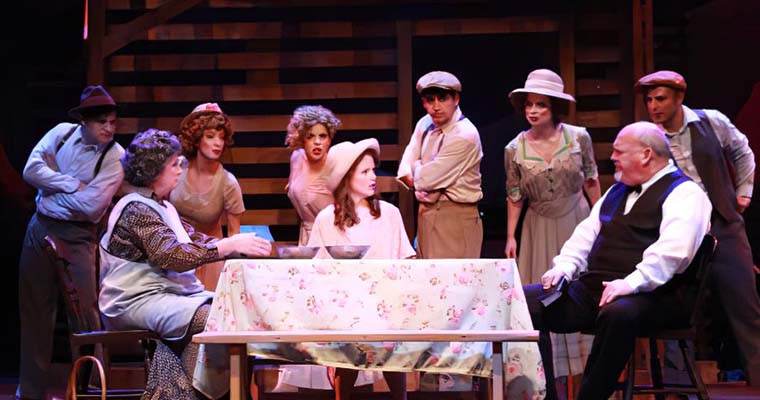
Paulette Oliva, Kimberly Doreen Burns, and Peter McClung fight over their family's future as the ensemble listens in. (Photo by Alberto Romeu)
“If you knew my story, you’d . . .have a good story to tell,” are among the opening lyrics to Steve Martin and Edie Brickell’s Tony-nominated Broadway bluegrass-folk musical, “Bright Star.”
You certainly would have a quality story to share.
In particular, it is a tale brimming with pain, passion, romance, happiness, humor, heartbreak, regret, tenderness, and forgiveness.
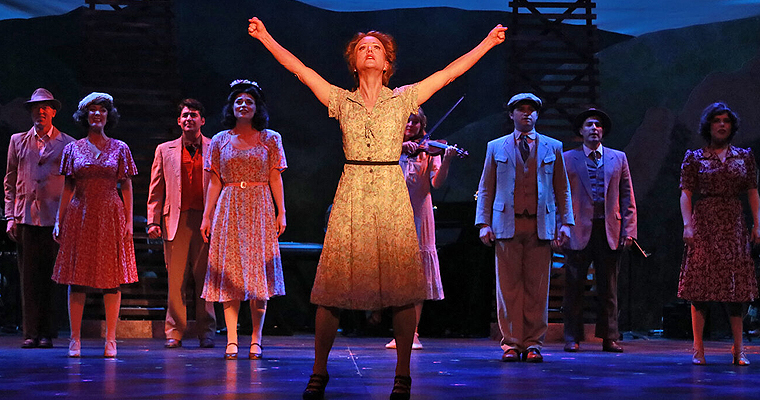
Kimberly Doreen Burns as Alice Murphy appears with the ensemble in Actors' Playhouse production of "Bright Star," running through Sunday, April 16. (Photo by Alberto Romeu)
Indeed, “Bright Star” is an emotionally-fulfilling, traditional musical. Fortunately, South Florida theatergoers and those visiting the region can conveniently experience the show since it is playing in their backyard through Sunday, April 16.
More specifically, Actors’ Playhouse at the Miracle Theatre in Coral Gables is giving “Bright Star” a powerful professional production. Undoubtedly, it will break your heart, imbue you with hope, and move you to experience a cathartic release following the show’s climax.
The musical takes place during the 1920s and 1940s in North Carolina. The show tells the story of a woman at two points in her life. Specifically, Alice Murphy (Kimberly Doreen Burns) is a wild teen in Zebulon, N.C. in the 1920s and a well-to-do literary magazine editor in 1940s Asheville, N.C.
“Bright Star” toggles between the two time periods as it recounts a shocking deed and that action’s connection to Murphy’s life.
Billy Cane (Teddy Warren), a young soldier who just returned from his service in World War II, inspires Murphy to examine her past. While doing so, she uncovers a life-changing secret.
A real historical incident – the story of the Iron Mountain baby – partly inspired “Bright Star.” The legend of the Iron Mountain baby concerns an infant who survives a great fall. Miraculously, someone finds him alive with only minor injuries on an embankment near a railroad bridge.
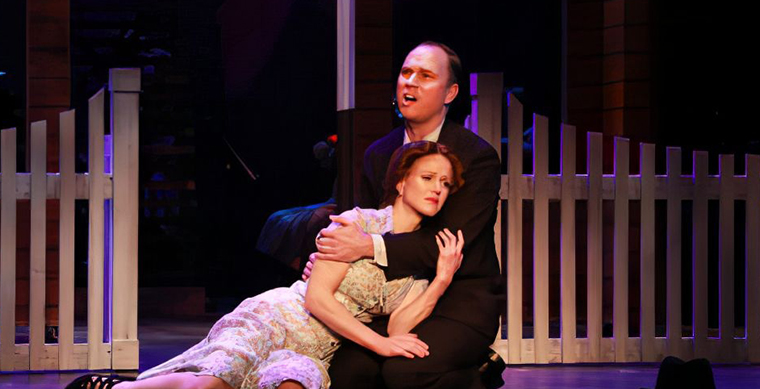
Kimberly Doreen Burns as Alice and Alex Jorth as Jimmy Ray appear in a scene from Actors' Playhouse's "Bright Star" now at the Miracle Theatre in Coral Gables. (Photo by Alberto Romeu)
While an action in the musical will surely shock many patrons, the production never veers into melodrama. That is a credit to director David Arisco, as well as a talented cast of South Florida-based and out-of-town actors. They tell the story with emotional sincerity and allow the humor and humanity to rise naturally from the tale. Also, under Arisco’s sensitive and detailed direction, it is easy to follow the story, even as it seesaws between the 1920s and 1940s.
Under Arisco’s astute direction, we never doubt how the characters feel about each other. In particular, hugs and kisses seem authentic. At least once, a character runs into another’s embrace and gets spun around. Also, a hand on someone’s shoulder clearly conveys a gesture of support.
The cast delivers first-rate performances, starting with Burns. The performer has an added challenge; she must portray Murphy as a teenager and, years later, an adult. Impressively, they sound and look like two different people.
Burns clearly differentiates between her character as a teenager and as an adult. For instance, she shifts her body and speaks in a higher-pitched voice as the younger woman. Also, as the teenage Murphy, Burns conveys more impulsivity and insecurity, but also an aura of independence and a strong-willed demeanor. She does not give in easily, even though women during thee 1920s enjoyed fewer rights than they do now.
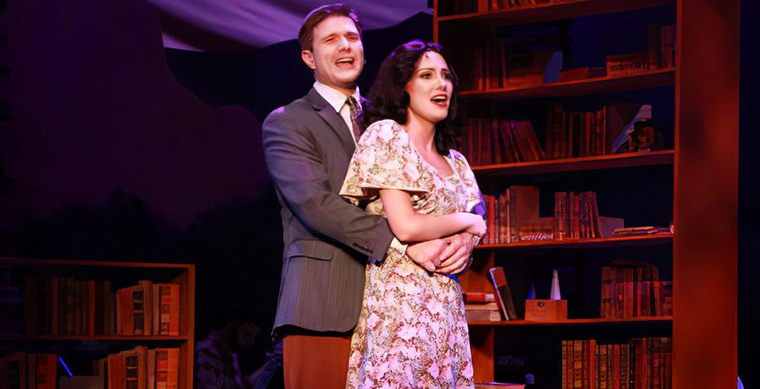
Teddy Warren as Billy Cane and Alexandra Van Hasselt as Margo Crawford in "Bright Star." (Photo by Alberto Romeu)
As an adult, Burns injects the older woman with confidence, patience, inner strength, and a polished air. In this multifaceted performance, Burns also believably conveys the character’s vulnerability.
As a singer, Burns demonstrates an impressive vocal range, and sings clearly while displaying deft vocal control. When Murphy sings “If You Knew My Story,” we sense that the character is itching to tell her tale.
In addition, Burns reaches with her arms to the other cast members, as though she is seeking their help in telling her character’s story. It is complex, and she cannot do it alone. Without a doubt, Burns shares the stage with talented castmates. They, too, possess clear, strong, and expressive voices and execute choreographer Sarah Crane’s physical dance moves with flair.
When the show starts, Warren as Cane has just returned from serving in World War II. Oddly, the character says little about his experiences. And, considering the toll war can take on a body, he looks too strong and energetic. Otherwise, Warren imbues the young man with believable eagerness, charm, and a touch of naiveté.
This contrasts nicely with Murphy’s worldliness and confidence. Burns, and Alex Jorth as Murphy’s love interest, Jimmy Ray Dobbs, display strong chemistry. As is the case with Burns, Jorth portrays his character as a teenager and adult, and succeeds admirably. As young Jimmy Ray, Jorth lends the young man a restless quality and an attractive charm. Also, Jorth makes us keenly sense his character’s passion and courage to stand up for what he believes in.
Obvious tension exists between Jimmy Ray and his father, Mayor Josiah Dobbs. The older man is a controlling and imposing individual, and Jim Ballard (who is married to lead actress Burns) commands the stage in the role without overshadowing his castmates.
A rich-sounding live band, with instruments such as a banjo and mandolin, accompanies the actors without coming close to drowning them out.
The energetic sound of this bluegrass-folk score befits the characters’ restlessness, particularly during scenes set in the 1920s. In addition, the score enhances the moods of scenes, which range from somber to upbeat. But even during dark moments, a sense of hope suffuses the action, reminding us that better days are not far off. Especially these days, we need encouraging, positive songs such as “Sun’s Gonna Shine” and the hope-filled title song.
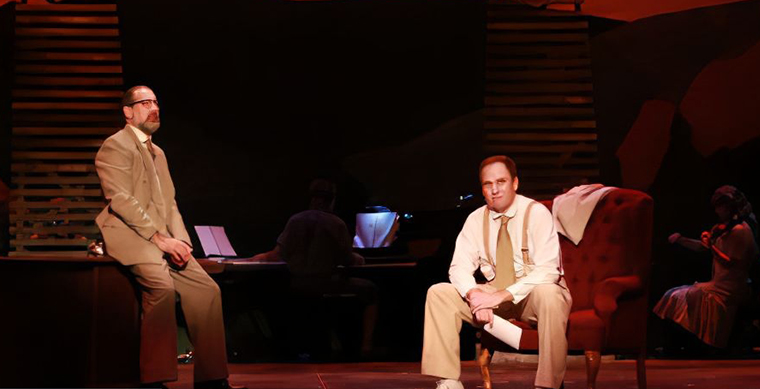
Jim Ballard as Mayor Josiah Dobbs and Alex Jorth as his son in "Bright Star." (Photo by Alberto Romeu)
Brandon Newton’s picturesque set, coupled with Eric Nelson’s varied lighting, also helps to reinforce a scene’s somberness or optimism and hope. Specifically, if you look into the distance, you will see what resembles mountains. Also, colors such as blue, yellow, orange, and red might suggest a clear blue sky, a sunset, or sunrise, with each corresponding to different emotional states. For instance, a clear blue sky and sunrise may signify happiness and hope.
The set also includes trestles, as well as a trestle bridge and train track that run across the top of the structures. Perhaps the bridge and track symbolize the emotional journey that these characters take. One of the structures resembles a hut, a part of which becomes a person’s backyard late in the show. Also, stand-alone set pieces, which smoothly enter and exit the stage, represent various locales, such as a bookstore.
Thanks, in part, to sound designer Shaun Mitchell, we can understand the actors, clad in Ellis Tillman’s period, character-appropriate costumes. Mitchell also created realistic-sounding effects.
True, “Bright Star” is a traditional musical that shares more characteristics with shows from the Golden Age than boundary-pushing, modern-day musicals. But if you listen to the winsome, bouncy score, you will hear a different sound from the one your grandparents heard when they attended musical theater productions.
Actors’ Playhouse’s production of "Bright Star" runs through Sunday, April 16 at the Miracle Theatre, 280 Miracle Mile in Coral Gables. Performances are at 8 p.m. Wednesday through Saturday, 3 p.m. on Sundays. Ticket prices range from $40 to $125. For tickets, call (305) 444-9923 or www.actorsplayhouse.org.




